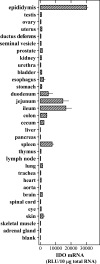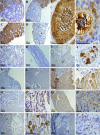Indoleamine 2,3-dioxygenase tissue distribution and cellular localization in mice: implications for its biological functions
- PMID: 19741271
- PMCID: PMC2796611
- DOI: 10.1369/jhc.2009.953604
Indoleamine 2,3-dioxygenase tissue distribution and cellular localization in mice: implications for its biological functions
Abstract
Earlier studies have suggested that indoleamine 2,3-dioxygenase (IDO) has a wide tissue distribution in mammals. However, detailed information on its cellular localization and also the levels of expression in various tissues is still scarce. In the present study, we sought to determine the cellular localization of IDO and also to quantify the level of its expression in various mouse tissues by using the branched DNA signal amplification assay, Western blotting, and immunohistochemical staining. The highest levels of constitutive IDO expression were found to be selectively present in the caput of epididymis, except for its initial segment. IDO expression was also detected inside the luminal compartment and even in the stereocilia within this region. In the prostate, high levels of IDO were selectively expressed in the capsular cells. In addition, high levels of IDO expression were also selectively detected in certain types of cells in the placenta, spleen, thymus, lung, and digestive tract. Notably, the morphological features of most of the positively stained cells in these organs closely resembled those of antigen-presenting cells. Based on the tissue distribution and cellular localization characteristics of IDO, it is hypothesized that its expression may serve two main functions: one is to deplete tryptophan in an enclosed microenvironment (such as in the epididymal duct lumen) to prevent bacterial or viral infection, and the other is to produce bioactive tryptophan catabolites that would serve to suppress T-cell-mediated immune responses against self-antigens, fetal antigens, or allogeneic antigens, in different situations.
Figures





References
-
- Bauer TM, Jiga LP, Chuang JJ, Randazzo M, Opelz G, Terness P (2005) Studying the immunosuppressive role of indoleamine 2,3-dioxygenase: tryptophan metabolites suppress rat allogeneic T-cell responses in vitro and in vivo. Transpl Int 18:95–100 - PubMed
-
- Beutelspacher SC, Pillai R, Watson MP, Tan PH, Tsang J, McClure MO, George AJ, et al. (2006) Function of indoleamine 2,3-dioxygenase in corneal allograft rejection and prolongation of allograft survival by over-expression. Eur J Immunol 36:690–700 - PubMed
-
- Britan A, Maffre V, Tone S, Drevet JR (2006) Quantitative and spatial differences in the expression of tryptophan-metabolizing enzymes in mouse epididymis. Cell Tissue Res 324:301–310 - PubMed
-
- Chiarugi A, Rapizzi E, Moroni F, Moroni F (1999) The kynurenine metabolic pathway in the eye: studies on 3-hydroxykynurenine, a putative cataractogenic compound. FEBS Lett 453:197–200 - PubMed
-
- Dai X, Zhu BT (2009) Suppression of T-cell response and prolongation of allograft survival in a rat model by tryptophan catabolites. Eur J Pharmacol 606:225–232 - PubMed
Publication types
MeSH terms
Substances
Grants and funding
LinkOut - more resources
Full Text Sources
Other Literature Sources
Molecular Biology Databases
Research Materials

